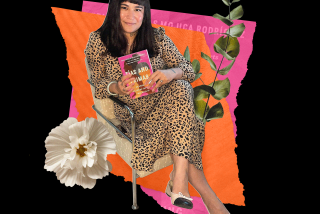‘La Llorona’ is more horrifying than ever in Jayro Bustamante’s subversive retelling
In the public sphere, an elderly military leader stands trial for genocide. At home, he fares no better. Outside the walls of his house, swarms of protesters demand that he be convicted; within them, he is tormented by a mysterious female figure at night.
The critically acclaimed “La Llorona” is Guatemalan director Jayro Bustamante’s third feature film (after “Ixcanul” and “Tremors”). It is also now his second to be a contender for an Oscar: Selected as Guatemala’s official submission for international feature, it made the category’s shortlist on Feb. 9. (“La Llorona” is available in the U.S. on the streaming platform Shudder.)
The film is inspired by the ghostly Latin American legend of La Llorona, about a woman who kills her own children so that she may get her lover back — and is then condemned to an afterlife spent mourning their deaths.
“La Llorona” represents the first foray into horror for Bustamante, who divides his time between Paris and Guatemala City. And while it boasts the trappings of a conventional fright flick, that doesn’t mean the filmmaker has abandoned his profound interest in the themes of social justice that have long infused his work.
“The three films I’ve made have a unifying theme in that they deal with three different abuses that highlight the social divide in relation to discrimination and division in Guatemala,” said Bustamante in a telephone interview shortly after the film’s U.S. release in August.
In “La Llorona” the abuse in question revolves around the genocide of Indigenous Maya peoples at the hands of the Guatemalan military in the 1980s — a real-life plotline that the director deftly weaves into a fictional horror movie format.
“It’s a topic we don’t want to discuss,” the director said of the genocide. “When someone does touch on it, they are accused of being a communist or a guerrilla. People pretend that things will simply be forgotten if they go unmentioned.
“Taking into account these elements, and the fact that Latin American audiences are very averse to auteur filmmaking and to films that touch on social issues, I thought the best approach was to disguise the film in a genre that is associated with entertainment,” he added. “That’s how the idea of working with the legend of La Llorona as the vehicle for this issue came about.”
Director Jayro Bustamante sets the story of the ‘wailing woman’ of lore in a Guatemala reckoning with its legacy of violence against Indigenous people.
Employing horror prevented the story from coming across as didactic or militant but risked alienating fervent genre fans — as evidenced by YouTube comments on the film’s trailer that question Bustamante’s art-house approach as well as the ways in which he altered the legend of La Llorona.
“I am not a proponent of horror, so I don’t have to respect its conventions for the sake of its fans,” he said. “There are many horror films that I love, but the joy of being a director is having the ability to travel from one genre to another with total freedom. Also, if the folklore isn’t revisited, it ends up dying, especially since it can be freighted with morals that are completely outdated — since they uphold virginity, machismo and keeping women locked up at home.”
Those familiar with recent Guatemalan history will recognize the principal villain in “La Llorona,” a general named Enrique Monteverde (played by Julio Díaz), as being inspired by the bloodthirsty former dictator Efraín Ríos Montt. Tried late in life for perpetrating crimes against humanity during his presidential term in the early 1980s, Ríos Montt died before he could serve any time.
By placing the character of Monteverde in the role of the haunted, the movie functions as a fictional reckoning.
“That may be an initial reading, but the real intention is to kill the dictator, the almighty alpha male, that system of oppression we have not abandoned,” said Bustamante. “It’s also about putting a generation ... in its place. People keep saying, ‘It’s true that my father was racist, sexist and homophobic, but he was a very nice guy.’”
In real life, Ríos Montt left behind a widow and a daughter who continue to defend the idea of a patriarch who didn’t deserve to be seen as a war criminal because he was purportedly a national hero. “I don’t know if they have seen my film,” said Bustamante, of the Ríos Montt clan. But he believes there were instances when bureaucratic obstacles were put in place to try to prevent him from filming. “Now everything is much more indirect,” he said. “What worries me the most is that what we do continues to be seen as a political attack, ignoring that art is a mirror of society, as well as the specific expression of whoever makes it.”
As in “Ixcanul,” his tragic coming-of-age story about a young woman in the Guatemalan highlands, “La Llorona” features the Maya community prominently (mostly as domestic employees in the home of the troubled general). The film also has the significant endorsement of activist and Nobel Peace Prize winner Rigoberta Menchú, who makes a cameo in a key courtroom scene.
Jayro Bustamante’s acclaimed ‘La Llorona’ reclaims a celebrated ghost story to expose the atrocities of Efraín Ríos Montt’s military dictatorship in Guatemala.
Though the story follows the personal and political trials of Monteverde, the film’s most crucial character is that of the general’s wife — magnificently played by the stately Margarita Kenefic.
“I wanted to transform La Llorona’s sexist leanings and remove the idea that she weeps because a man left her and that this is what pushes her to kill her children,” explained Bustamante. “I also didn’t want to present her as a monster, the way Hollywood has done it. To that end, Dracula was very useful, since he has always been represented with great elegance.”
For his version of the legend, Bustamante said, “the idea that La Llorona is a lost soul who can’t harm you remained the same.”
“But in our case she can possess the women around her,” he continued, “to seek in them the empathy she needs to put an end to this phallocentric system, attacking them with their own fears and through the shells they have built.”
Times columnist Carolina Miranda and Carlos Aguilar contributed to this report.
More to Read
Only good movies
Get the Indie Focus newsletter, Mark Olsen's weekly guide to the world of cinema.
You may occasionally receive promotional content from the Los Angeles Times.










